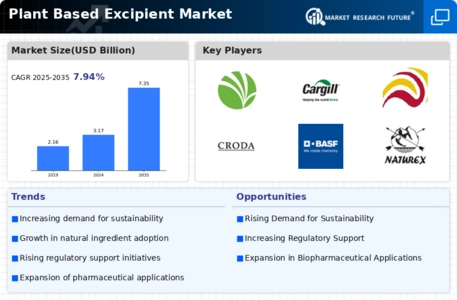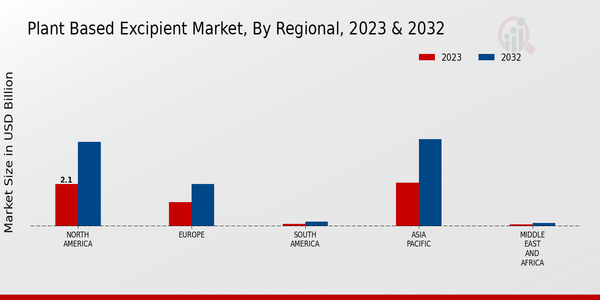Market Growth Projections
The Global Plant Based Excipient Market Industry is poised for substantial growth, with projections indicating an increase from 3.17 USD Billion in 2024 to 7.35 USD Billion by 2035. This growth trajectory suggests a robust compound annual growth rate (CAGR) of 7.95% from 2025 to 2035. Such figures reflect the increasing adoption of plant-based excipients across various sectors, including pharmaceuticals, food, and cosmetics. The market's expansion is likely driven by a combination of consumer demand for natural products, regulatory support, and advancements in extraction technologies, positioning plant-based excipients as a key component of future formulations.
Growing Awareness of Health Benefits
The Global Plant Based Excipient Market Industry is witnessing a rise in awareness regarding the health benefits associated with plant-based ingredients. Consumers are increasingly informed about the potential advantages of using natural excipients, such as improved bioavailability and reduced side effects. This awareness is particularly pronounced in the pharmaceutical sector, where the efficacy of drug formulations can be enhanced through the use of plant-derived excipients. As a result, manufacturers are increasingly incorporating these ingredients into their products, contributing to the market's growth and the projected increase in value to 7.35 USD Billion by 2035.
Rising Demand for Natural Ingredients
The Global Plant Based Excipient Market Industry experiences a notable surge in demand for natural ingredients, driven by consumer preferences shifting towards more sustainable and health-conscious products. This trend is particularly evident in the pharmaceutical and food sectors, where plant-based excipients are increasingly favored for their safety and efficacy. As of 2024, the market is valued at 3.17 USD Billion, reflecting a growing recognition of the benefits associated with plant-derived materials. This shift not only aligns with consumer expectations but also supports regulatory initiatives aimed at reducing synthetic additives, thereby enhancing the appeal of plant-based alternatives.
Regulatory Support for Plant-Based Solutions
The Global Plant Based Excipient Market Industry benefits from increasing regulatory support that encourages the use of plant-derived excipients. Governments and health organizations are promoting the adoption of natural ingredients in pharmaceuticals and food products, which is likely to enhance consumer safety and environmental sustainability. This regulatory landscape is conducive to innovation and investment in plant-based technologies, as companies seek to comply with evolving standards. The anticipated growth of the market, projected to reach 7.35 USD Billion by 2035, underscores the importance of regulatory frameworks in fostering a favorable environment for plant-based excipients.
Sustainability and Environmental Considerations
Sustainability concerns are driving the Global Plant Based Excipient Market Industry as consumers and manufacturers alike prioritize environmentally friendly practices. The shift towards plant-based excipients is seen as a viable solution to reduce the carbon footprint associated with synthetic alternatives. Companies are increasingly adopting sustainable sourcing practices and transparent supply chains to meet consumer expectations for eco-friendly products. This trend is likely to bolster the market's growth, with projections indicating a rise to 3.17 USD Billion in 2024 and a significant expansion towards 7.35 USD Billion by 2035, reflecting the growing alignment of business practices with sustainability goals.
Technological Advancements in Extraction Processes
Technological advancements in extraction and processing methods are significantly influencing the Global Plant Based Excipient Market Industry. Innovations such as green extraction techniques and bioprocessing are enhancing the efficiency and yield of plant-derived excipients, making them more accessible and cost-effective. These advancements not only improve the quality of the excipients but also reduce the environmental impact associated with traditional extraction methods. As the market evolves, these technologies are expected to play a crucial role in meeting the growing demand for high-quality plant-based alternatives, thereby supporting the projected CAGR of 7.95% from 2025 to 2035.



 Source: Primary Research, Secondary Research, Market Research Future Database and Analyst Review
Source: Primary Research, Secondary Research, Market Research Future Database and Analyst Review
















